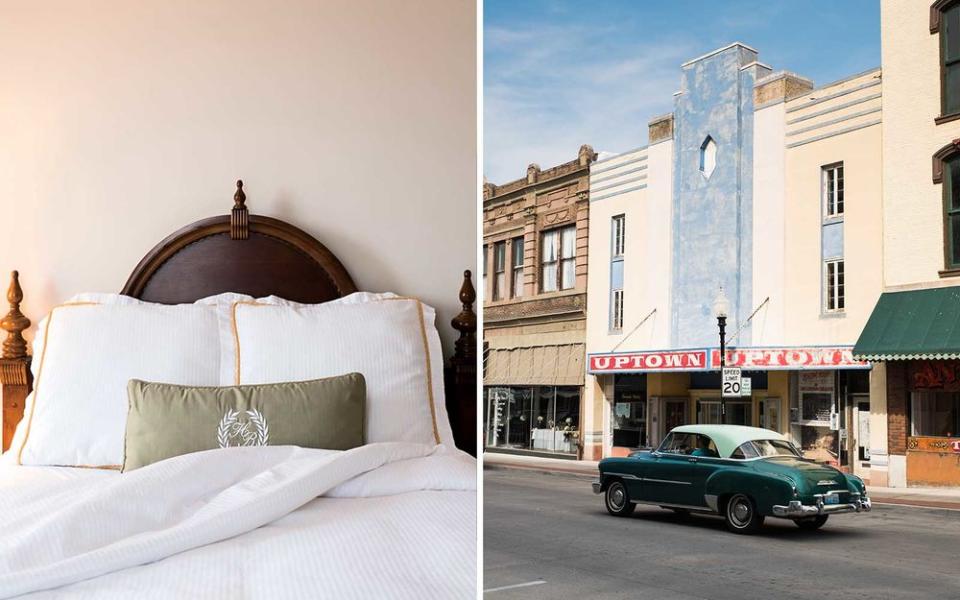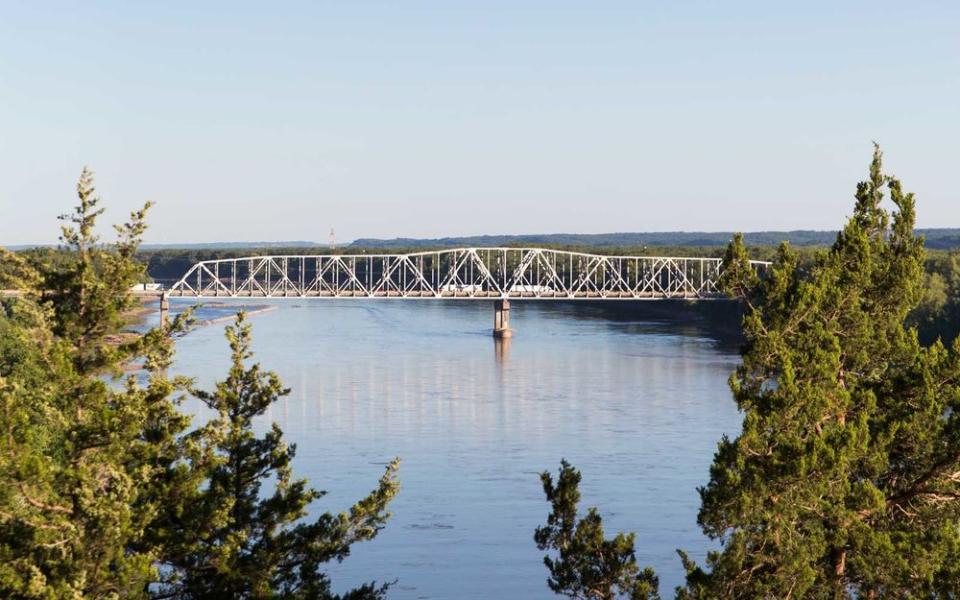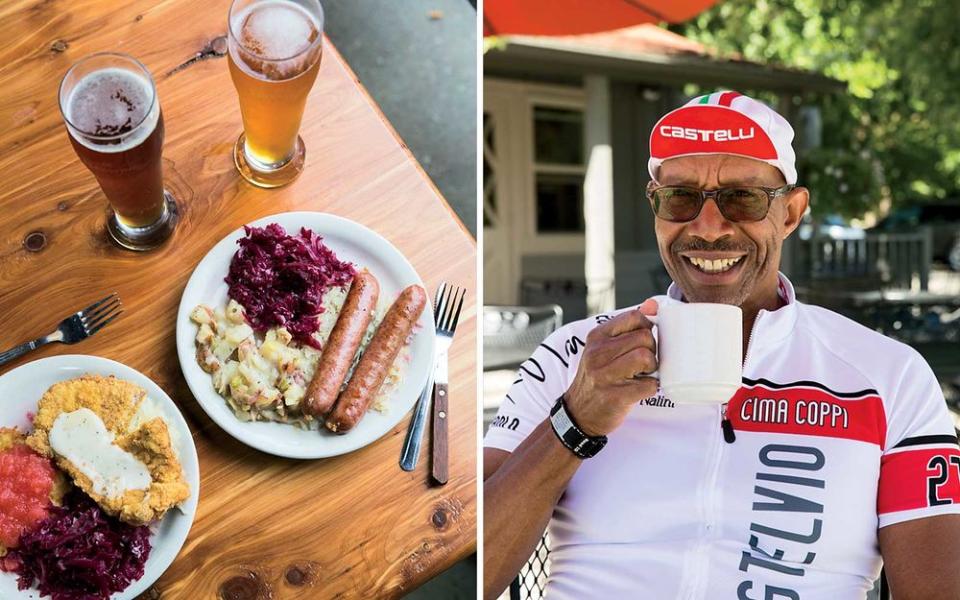Biking Missouri's Katy Trail
Running across the middle of Missouri, along the state's namesake river, you'll find the Katy Trail. It's the width of a single-lane highway, as flat as a griddle, and impossibly straight—or maybe it just seems that way from the seat of a bike. Gravel the color of cappuccino foam stretches far ahead, disappearing into a pinhole on the horizon. In some places, you could close your eyes and pedal for half an hour without crashing.
Until 1986, the trains of the Missouri-Kansas-Texas Railroad (MKT, nicknamed the "Katy") ran along this route. A few years later, the rails were pulled up and the land was repurposed, becoming one of the first major rail-trail conversions in the U.S. Today there are more than 23,400 miles of these paths across the country. At 240 miles, the Katy Trail is the longest—and it's still growing. When the Rock Island Trail to the south is completed, it will link up with the Katy to form a 450-mile loop through Missouri.
Last spring, I rode the Katy with my pal Zach. He and I grew up about 50 miles from the trail's midpoint, but back then we'd been too preoccupied by adolescence for long, multiday bike rides. Spurred by the completion of the first 48-mile spur of the Rock Island Trail, we decided to change that. On an overcast Sunday, we set out from the outskirts of Kansas City like kids on summer break, stopping to snap photos of grain silos towering over the trail and cows pushing wet noses through fences. Seventy miles later, legs heavy and faces caked with dust, we arrived in Sedalia at the 91-year-old Hotel Bothwell, a 53-room spot with a posh veneer and free bike storage.

In the morning, as we were about to head out, we heard a sudden pop. My front rim got pinched in the freight elevator. It would take two days to deliver a new wheel, but Sedalia, a colorful former brothel town, turned out to be the stopover we didn't know we needed. We ate cheeseburgers with peanut butter, a Sedalia delicacy, at Goody's Steakburgers and toured the Katy Depot museum. At Pro-Velo Cycle Sports, owner Ebby Norman described the appeal of the Katy, as he saw it: "If you want to see the country, the eleven or twelve miles per hour you travel on a bike is just about perfect."
It was drizzling when my wheel arrived, so we threw on rain gear and set out as droplets crackled against the leaves overhead. I marveled at the limestone bluffs looming to my left and the Missouri River moving slowly to my right, skirting the northern edge of the Ozark Plateau. My legs seemed to match pace with the current. When the rain stopped, bullfrog calls and birdsong filled the void. A harrier hawk glided ahead, flying a couple of feet above the trail.

When I lived here, I didn't appreciate all this tranquility. I turned up my nose at the brown, lazy Missouri River. Locals affectionately call it the Big Muddy, but to me it looked like refried beans. After college, I moved to New York and spent years living as fast as I could. Returning home, I realized how much I could gain from slowing down.
That night, we stopped at the Katy Trail B&B, in the tiny town of Rocheport. Owner Brett Dufur swung by with a six-pack. Because the Katy runs along a railway, he said, "there are these quirky towns every few miles. You can push yourself, but you can always get a cold beer just up ahead."
Cold beer sounded great, so the next day we detoured to Columbia, my old college town. Flat Branch Pub & Brewing (flatbranch.com) is a place I used to visit often, but I'd never ordered the Katy Trail Pale Ale. It was sweet and refreshing.

Down the road in Hermann, a historically German town, we found the best meal of the trip. At Hermann Wurst Haus, we sampled headcheese and a liver sausage called braunschweiger, then ordered wursts with tight skins. We washed it all down with rauchbier at Tin Mill Brewery next door. After dark, we flicked on our headlights and rode to Joey's Birdhouse, a homey inn run by Joey Los, the mayor of McKittrick, Missouri. Last year she took office with four votes. Not by four votes—four votes total. When we woke, the mayor cooked us breakfast with vegetables from her garden.
The beer legacy of Missouri, home to Anheuser-Busch, is well known. But German immigrants also identified the Missouri River Valley as an ideal spot for growing grapes. Augusta was the nation's first recognized wine region, and today, clustered around the old German settlements, you'll find more than 100 wineries. Dufur had advised us to approach their product with an open mind. "Our wines are good, and they win awards, but most people aren't used to the varietals we have here."

At Augusta Winery, Zach and I pushed through a crowded room for a tasting. Sure enough, there were no Rieslings or Merlots. Instead, we drank Vignoles, Vidal Blanc, and Chambourcin, a dry nectar thick with spicy blackberry flavor. And it dawned on me: without the Big Muddy, this wine wouldn't be possible. The water is brown because it's rich with silt and loam. The slow-moving current holds a potent punch of minerals that get deposited into the floodplain, from which they move on to the vines.
Staring into my glass, the river's pace and color began to seem like marks of quality rather than flaws. You can take the good with the bad: a rainy day for every great wurst, a broken wheel for every mayor who cooks you breakfast. That's easier to see when you slow down. Eleven or 12 miles an hour is just about perfect.

